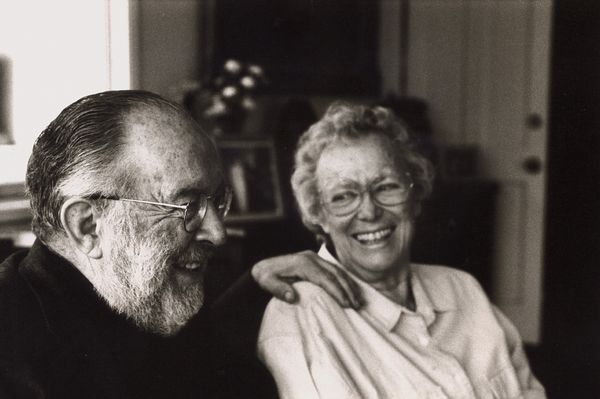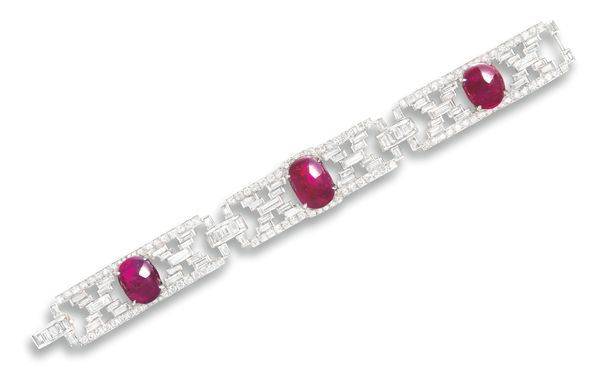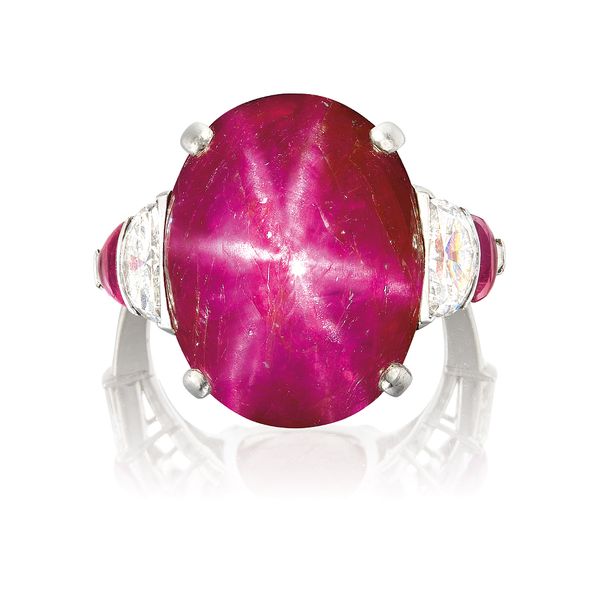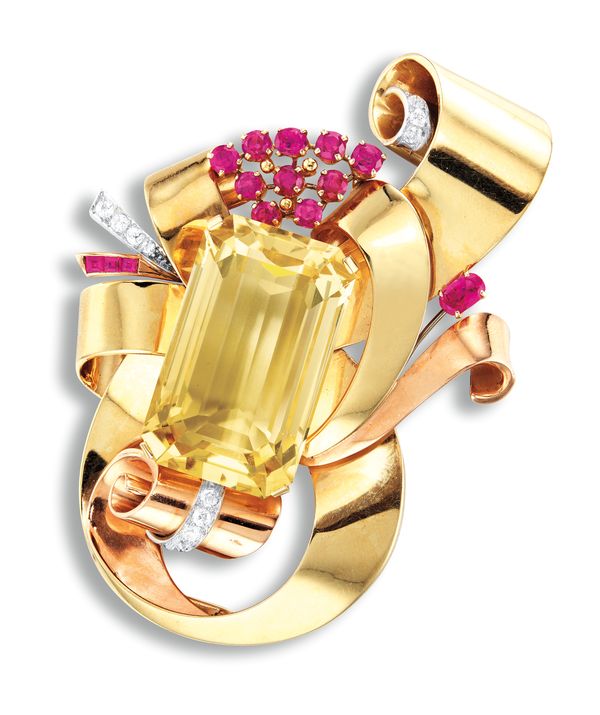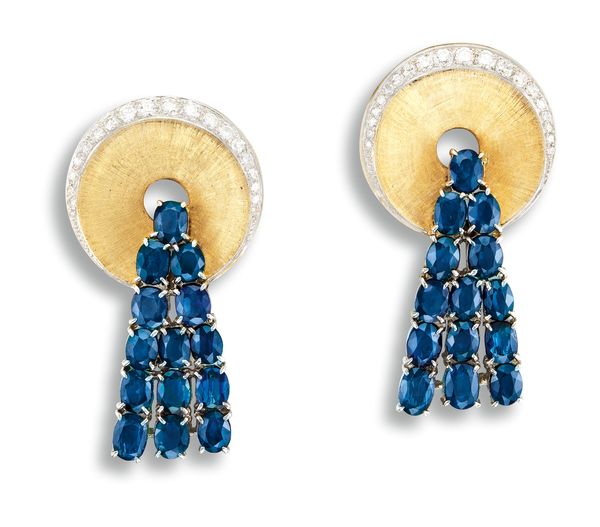Betty and Stanley in their Los Angeles home circa 2000
This spring in Hong Kong, we present a collection of jewels belonging to Betty Warner Sheinbaum, heiress to one of the most successful motion picture and television dynasties in the world, Warner Bros. Betty was born the youngest daughter of Harry and Rea Warner in New York City in 1920. In 1923, Warner Bros. Pictures, Inc. was officially established as one of the first movie studios in the world and Harry, the first President of the company, moved his family to Los Angeles. There, Betty was immersed in the glamour of the Hollywood motion pictures scene, mingling with famed Hollywood actors, directors and producers on the sets of Warner Bros. studios and attending star-studded events. At age 19, Betty married her first husband, the screenwriter and producer Milton Sperling, with whom she had four children.
While considered Hollywood royalty, Betty was a modest person who led her life with a distinctive sense of independence and purpose — she was highly educated, an accomplished artist, a voracious collector of contemporary art and a political activist alongside her second husband Stanley Sheinbaum. Together, the Sheinbaums dedicated themselves to human rights, social justice, education, politics and world affairs, leaving behind a legacy of both significant patronage to art and positive political change.
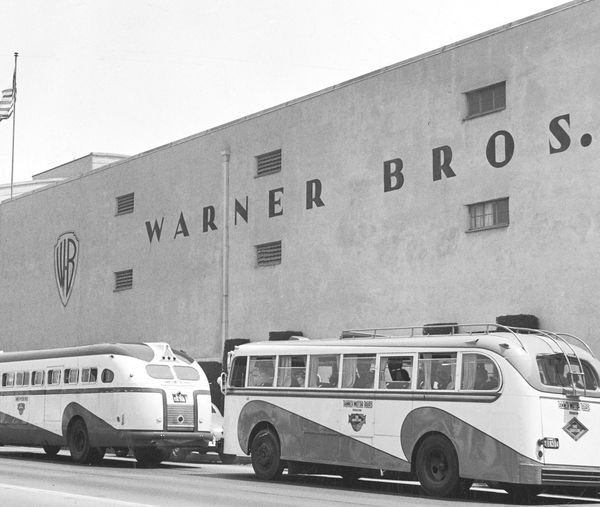
Three tour buses in front of the Warner Bros. studios, Hollywood, California, 1946.
Betty Warner Sheinbaum's collection of jewels evokes a sense of the "Goldenage of Hollywood." As Penny Proddow, Debra Healy and Marion Fasel explain in their book Hollywood Jewels, every decade in Hollywood brought with it a renewal of popular actresses, technologies and, of course, fashions and styles. There was a constant evolution in the relationship shared between films, movie stars and jewelry. The jewels in this collection represent the changing landscape of styles that took place on and off-screen from the early 20th century until the 1950s.
In the mid-1920s and 1930s, Warner Bros. introduced and developed the use of sound in motion pictures. This advancement brought a strong emphasis on adorning Hollywood's great actresses with impressive jewels in order to enhance their on-screen appeal. Incredible jewelry became a staple of screen actresses' wardrobes, with jewels lent by the famed jewelry houses of New York and Paris. This technological evolution coincided with the 1925 Exposition Internationales des Arts Decoratifs where Mauboussin unveiled the ubiquitous wide bracelet. The wide bracelet soon became a symbol of Hollywood glamour, with diverse versions stacked to adorn the wrists of the screen's most famous actresses, mounted with precious stones set against fancy-cut diamonds.
Incredible jewelry became a staple of screen actresses' wardrobes, with jewels lent by the famed jewelry houses of New York and Paris.
An Art Deco Ruby and Diamond Bracelet, 1930s
Lot 549 is a good example of this popular style of bracelet comprising an Art Deco diamond bracelet set with three oval cabochon rubies against a background of staggered baguette cut diamonds. As Hollywood's films and actresses increasingly influenced the fashions of the world, fine New York jewelers such as Trabert & Hoefer Mauboussin and Paul Flato opened branches in Hollywood.
Many of the jewels owned personally by actresses also began making their way into film, with jewelers offering screen credits in exchange for their exclusive designs. It is said that Marlene Dietrich was so attached to her own suite of cabochon emerald and diamond jewels made for her by Mauboussin that she wore them in several of her movies. In fact, the cabochon itself, a cut previously thought of as unfashionable, was elevated to a Hollywood bestseller by actresses who recognized the allure of a curved, colored stone on camera. The cabochon became the mark of the extravagant fashionable woman. Faceted stones were swapped for cabochon emeralds, and star rubies and sapphires, such as Lot 537, a 1930s cabochon Burmese ruby ring flanked by crescent-shaped diamonds and rubies.
An Art Deco Star Ruby and Diamond Ring, Circa 1930
In the 1940s, Hollywood actresses turned their attention to jewelry designs that later came to be known as 'Retro'. The style drew on the 'daytime' jewelry designs of the 1930s but emerged in wartime with a bolder, albeit austere look, enabling the wearer to transition from day to night in a style that came to be known as 'one jewel dressing'. Rings, cuffs and brooches worked in polished gold were generously adorned with large-scale gemstones such as citrines and aquamarines.
A Retro Citrine, Ruby and Diamond Brooch, 1940s; Pair of Retro Sapphire and Diamond Clip Brooches, together with Bangle Fitting, 1940s
Lot 535, a Retro Brooch, is a fine example of this style of brooch centring a rectangular citrine of approximately 55.00 carats. A type of cuff bracelet also emerged, consisting of removable clip brooches to give the wearer versatility. Lot 536 is an example of this comprising two attractive sapphire and diamond 'comet' clip brooches, which can be worn on a cuff bangle fitting. The 1950s ushered the return of glamour to the jewels of Hollywood with the advent of technicolor cinematics. Platinum, diamonds and pearls returned to the screen as the building blocks of wardrobing for Hollywood's leading ladies. Multi-strand pearls and three dimensional-diamond and colored stone brooches dominated scenes. Jewelers like Van Cleef & Arpels were commissioned to produce exceptional jewels for actresses like Grace Kelly and Marlene Dietrich to wear both on and off-screen.
It is our pleasure to offer the present collection of jewels as both a testament to the changing face of Hollywood and its jewels, as well as part of the legacy of one of Hollywood's most notable families.
